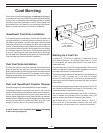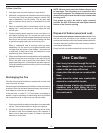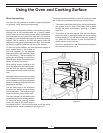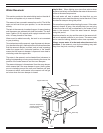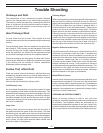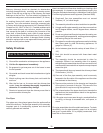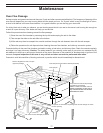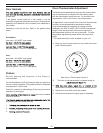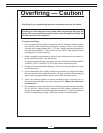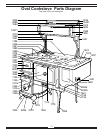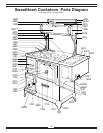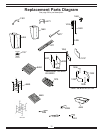
28
Flue Boot Inspection
Remove the cover plate on the ue boot, located at the back
of the range. Inspect for soot or creosote buildup, scrape and
clean as much as possible, and remove debris through the
clean out door with the ash scraper.
Oven Damper
The oven damper may stick from time to time because
of a buildup of ashes or creosote in the damper track. To
free up the damper, scrape out the buildup or spray with a
creosote remover, let sit for about 1/2 hour and clean out
debris. (Caution: Never use any remover or cleaner on a
hot stove.)
Chimney Maintenance
Chimney serving woodburning appliances must be checked
regularly for creosote build-up. The rate of build-up depends
on cookstove and chimney characteristics, the type of fuel
used, and on how the system is operated.
Until you are familiar with the rate of creosote build-up in the
system, check it often - every couple of weeks. Well-designed
woodburning systems tend to have a slower rate of build-up
in the spring and fall when heat demand, and therefore ring
rate, is lower.
Creosote may be in the form of dry, aky deposits clinging
to the liner, or a shiny, glazed coating that looks like black
paint.
Glazed creosote is the most dangerous kind and indicates
that one or a combination of conditions exist in the system
that can cause the deposits;
1) a cold liner
2) smouldering res
3) wet wood
Glazed creosote should never be allowed to exceed 1/8”(3
mm ) in thickness, Dry, aky creosote should be removed
when it reaches 6 mm (1/4”) in thickness.
Chimney Cleaning Equipment
Brushes and rods are the most common chimney cleaning
equipment. Plastic brushes are normally used in metal
chimneys and steel brushes are used for masonry chimney.
The brush should t snugly in the chimney so that enough
friction is produced to remove deposits. Most chimney cleaning
rods are made from breglass with threaded couplings at
each end. Several passes with the brush are needed for a
thorough cleaning.
Many homeowners prefer to contact the services of a chimney
sweep rather than climbing on their roofs to clean the chimney.
An experienced chimney sweep can complete the job quickly
and will leave no mess behind. The sweep will also report
on the condition of the chimney. Referrals are the best way
to select a chimney sweep. Check with your neighbours to
see if they are satised with the sweeping services they have
received.
Cooking Surface
After the initial ring, your stove top will start to turn colour.
This is normal and eventually the stove top will have a uniform
blue nish.
The stove tops and lids are highly polished untreated cast
iron. To minimize the potential for permanent stains,
always maintain the top with cooking oil. During periods
of heavy use, a light coating is sufcient. When you will
not be using the stove for a week or more, give the top
a heavier coat and re-apply as needed. Always remove
food, water or rust stains as quickly as possible. If such
stains are left unattended, a permanent mark can result.
To help remove stains, use a medium/ne aluminium oxide
abrasive sanding block, available at most hardware stores,
or a metal cleaner such as Flitz, in conjunction with ne
(000) steel wool. Do not be afraid to use elbow grease.
Stove top and/or keyplate may expand during heating and
use - this is normal and slight gaps may appear around
key plate. The natural expansion and contraction of the
keyplate during heating is not unusual.
At the end of the heating season, especially in a seasonal
location, apply a coat of cooking oil to keep the top from rusting.
Please note - Owners of SweetHeart Cookstove: There
is an expansion joint at the rear of the cooking surface
on the rebox side. The purpose of this joint is to allow
the top to expand and contract as required.
Nickel Trim
Nickel trim must be cleaned with warm soapy water and a
micro cloth
Porcelain
Never clean porcelain while the stove is hot. Porcelain is glass
and sudden changes in temperature may cause cracking.
Clean porcelain surfaces with glass cleaner or polish and
a soft cloth. Oven stains may be removed with household
oven cleaner.
Please Note: The spilling of acids like vinegar or lemon juice
on the porcelained reservoir could leave a permanent stain.



